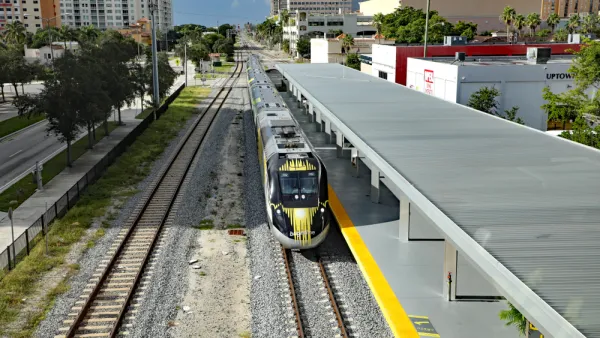Stimulus funds directed at high speed rail projects have inspired a flood of lobbying efforts across the country, according to this analysis from the Center for Public Integrity.
"[A]fter millions and millions of dollars spent studying, planning, and mostly falling short, the American incarnation of high-speed passenger rail is but a single line that travels from Washington to Boston at an average speed of under 80 miles per hour.
Now, though, the Obama administration is looking to change all that, starting with $8 billion in federal stimulus money to be awarded starting this winter. Equally captivated, Congress is considering adding as much as $4 billion more in next year's budget. The House Transportation and Infrastructure Committee chairman, James Oberstar, a Minnesota Democrat, is talking $50 billion after that.
That helps explain the U.S. High Speed Rail Association, which didn't even exist a year ago. Actually, the group was just formed in June, and the timing is no accident. High-speed rail is Washington's latest potential bonanza, it seems, and that $8 billion dollars - just for starters - is attracting lots of attention. In fact, an examination by The Center for Public Integrity found that more than 50 public and private groups explicitly lobbied on high-speed rail policy last quarter - a three-fold increase from a year ago. Even that number fails to capture dozens of other actors likely lobbying on high-speed rail that keep their specific lobbying targets as vague as Washington does its spending plans."
FULL STORY: Washington's Newest Gravy Train: High-Speed Rail

National Parks Layoffs Will Cause Communities to Lose Billions
Thousands of essential park workers were laid off this week, just before the busy spring break season.

Retro-silient?: America’s First “Eco-burb,” The Woodlands Turns 50
A master-planned community north of Houston offers lessons on green infrastructure and resilient design, but falls short of its founder’s lofty affordability and walkability goals.

Delivering for America Plan Will Downgrade Mail Service in at Least 49.5 Percent of Zip Codes
Republican and Democrat lawmakers criticize the plan for its disproportionate negative impact on rural communities.

Test News Post 1
This is a summary

Test News Headline 46
Test for the image on the front page.

Balancing Bombs and Butterflies: How the National Guard Protects a Rare Species
The National Guard at Fort Indiantown Gap uses GIS technology and land management strategies to balance military training with conservation efforts, ensuring the survival of the rare eastern regal fritillary butterfly.
Urban Design for Planners 1: Software Tools
This six-course series explores essential urban design concepts using open source software and equips planners with the tools they need to participate fully in the urban design process.
Planning for Universal Design
Learn the tools for implementing Universal Design in planning regulations.
EMC Planning Group, Inc.
Planetizen
Planetizen
Mpact (formerly Rail~Volution)
Great Falls Development Authority, Inc.
HUDs Office of Policy Development and Research
NYU Wagner Graduate School of Public Service




























